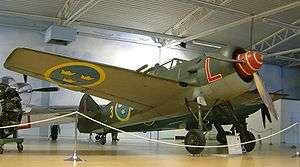
FFVS 22
The FFVS J 22 was a single-engine fighter aircraft developed for the Swedish Air Force during World War II.
Development
At the onset of World War II, the Swedish Air Force (Flygvapnet) was equipped with largely obsolete Gloster Gladiator (J 8) biplane fighters. To augment this, Sweden ordered 120 Seversky P-35 (J 9) and 144 P-66 Vanguard (J 10) aircraft from the United States. However, on 18 June 1940 after the German occupation of Norway, the United States declared an embargo against exporting weapons to any nation other than Great Britain. As the result, Flygvapnet suddenly faced a shortage of modern fighters. Several other foreign alternatives were considered: the Finnish VL Myrsky and Soviet Polikarpov I-16 were unsatisfactory, and while the Mitsubishi A6M Zero was available, delivery from Japan was impractical. A batch of Fiat CR.42 Falco (J 11) biplanes and Reggiane Re.2000 Falco (J 20) were eventually purchased but this was clearly an interim solution.
With Flygvapnet facing a serious shortage of aircraft and Saab running at full capacity building its single-engine Saab 17 and twin-engined Saab 18 bombers, a new firm and factory were established specifically for the new fighter — Kungliga Flygförvaltningens Flygverkstad i Stockholm ("Royal Air Administration Aircraft Factory in Stockholm", FFVS) under Bo Lundberg. The aircraft, designated J 22, was a monoplane with a plywood-covered steel airframe. Wing and fuselage layout were conventional, with the narrow-track main landing gear retracting rearward entirely within the fuselage, somewhat similar to the 1935 Focke-Wulf Fw 159 parasol-wing monoplane fighter design. Power came from a Swedish copy of the Pratt & Whitney R-1830 Twin Wasp, manufactured without a license at the time, though license fees were paid later (a symbolic US$1).

J/22
The International J/22 is a popular fixed-keel one-design racing sailboat normally raced with a crew of three or four people (total crew weight is restricted to 275 kg/605 lb). It races with the "class jib," a non-overlapping jib, a mainsail, and a large spinnaker. The boat is capable of planing on reaches and runs.
There are over 1,600 J/22's now sailing in 65 active fleets in eighteen countries on three continents. Recognized by the ISAF, the International J/22 Class Association promotes activities and regattas worldwide. There is a very active class web site and association newsletters. For class racing, sails are restricted to only a main, small jib and spinnaker with total crew weight at 605 lb.. According to the builder, "There is no better One-Design value available in a 22' keelboat."
The J/22 is used in the USA Women's Match Racing Championship regatta, resulting in the Santa Maria Cup
Design
According to its builder, "Since its introduction in 1983, the J/22 has blossomed into an International class now with 1,600+ boats sailing in 65 fleets in 18 countries. Over 130 boats sailed in the 2004 World Championship. On the merits of its sailing characteristics, widespread popularity and small crew number (3–4), J/22 continues to be the boat of choice and is selected again for the 2005 Rolex International Women's Keelboat Championship in Annapolis, MD."
J22
J22, J 22 or J-22 may refer to:
See also
Podcasts:

